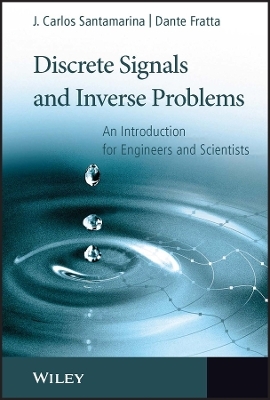
Discrete Signals and Inverse Problems
John Wiley & Sons Inc (Verlag)
978-0-470-02187-3 (ISBN)
Based on the original ‘Introduction to Discrete Signals and Inverse Problems in Civil Engineering’, this expanded and enriched version:
combines discrete signal processing and inverse problem solving in one book
covers the most versatile tools that are needed to process engineering and scientific data
presents step-by-step ‘implementation procedures’ for the most relevant algorithms
provides instructive figures, solved examples and insightful exercises
Discrete Signals and Inverse Problems is essential reading for experimental researchers and practicing engineers in civil, mechanical and electrical engineering, non-destructive testing and instrumentation. This book is also an excellent reference for advanced undergraduate students and graduate students in engineering and science.
J. Carlos Santamarina, Civil and Environmental Engineering, Georgia Institute of Technology, Atlanta, GA 30332-0355, USA Dante Fratta, 3418H CEBA, Civil and Environmental Engineering, Louisiana State University, Baton Rouge, LA 70803, USA
Preface xi
Brief Comments on Notation xiii
1 Introduction 1
1.1 Signals, Systems, and Problems 1
1.2 Signals and Signal Processing – Application Examples 3
1.3 Inverse Problems – Application Examples 8
1.4 History – Discrete Mathematical Representation 10
1.5 Summary 12
Solved Problems 12
Additional Problems 14
2 Mathematical Concepts 17
2.1 Complex Numbers and Exponential Functions 17
2.2 Matrix Algebra 21
2.3 Derivatives – Constrained Optimization 28
2.4 Summary 29
Further Reading 29
Solved Problems 30
Additional Problems 33
3 Signals and Systems 35
3.1 Signals: Types and Characteristics 35
3.2 Implications of Digitization – Aliasing 40
3.3 Elemental Signals and Other Important Signals 45
3.4 Signal Analysis with Elemental Signals 49
3.5 Systems: Characteristics and Properties 53
3.6 Combination of Systems 57
3.7 Summary 59
Further Reading 59
Solved Problems 60
Additional Problems 63
4 Time Domain Analyses of Signals and Systems 65
4.1 Signals and Noise 65
4.2 Cross- and Autocorrelation: Identifying Similarities 77
4.3 The Impulse Response – System Identification 85
4.4 Convolution: Computing the Output Signal 89
4.5 Time Domain Operations in Matrix Form 94
4.6 Summary 96
Further Reading 96
Solved Problems 97
Additional Problems 99
5 Frequency Domain Analysis of Signals (Discrete Fourier Transform) 103
5.1 Orthogonal Functions – Fourier Series 103
5.2 Discrete Fourier Analysis and Synthesis 107
5.3 Characteristics of the Discrete Fourier Transform 112
5.4 Computation in Matrix Form 119
5.5 Truncation, Leakage, and Windows 121
5.6 Padding 123
5.7 Plots 125
5.8 The Two-Dimensional Discrete Fourier Transform 127
5.9 Procedure for Signal Recording 128
5.10 Summary 130
Further Reading and References 131
Solved Problems 131
Additional Problems 134
6 Frequency Domain Analysis of Systems 137
6.1 Sinusoids and Systems – Eigenfunctions 137
6.2 Frequency Response 138
6.3 Convolution 142
6.4 Cross-Spectral and Autospectral Densities 147
6.5 Filters in the Frequency Domain – Noise Control 151
6.6 Determining H with Noiseless Signals (Phase Unwrapping) 156
6.7 Determining H with Noisy Signals (Coherence) 160
6.8 Summary 168
Further Reading and References 169
Solved Problems 169
Additional Problems 172
7 Time Variation and Nonlinearity 175
7.1 Nonstationary Signals: Implications 175
7.2 Nonstationary Signals: Instantaneous Parameters 179
7.3 Nonstationary Signals: Time Windows 184
7.4 Nonstationary Signals: Frequency Windows 188
7.5 Nonstationary Signals: Wavelet Analysis 191
7.6 Nonlinear Systems: Detecting Nonlinearity 197
7.7 Nonlinear Systems: Response to Different Excitations 200
7.8 Time-Varying Systems 204
7.9 Summary 207
Further Reading and References 209
Solved Problems 209
Additional Problems 212
8 Concepts in Discrete Inverse Problems 215
8.1 Inverse Problems – Discrete Formulation 215
8.2 Linearization of Nonlinear Problems 227
8.3 Data-Driven Solution – Error Norms 228
8.4 Model Selection – Ockham’s Razor 234
8.5 Information 238
8.6 Data and Model Errors 240
8.7 Nonconvex Error Surfaces 241
8.8 Discussion on Inverse Problems 242
8.9 Summary 243
Further Reading and References 244
Solved Problems 244
Additional Problems 246
9 Solution by Matrix Inversion 249
9.1 Pseudoinverse 249
9.2 Classification of Inverse Problems 250
9.3 Least Squares Solution (LSS) 253
9.4 Regularized Least Squares Solution (RLSS) 255
9.5 Incorporating Additional Information 262
9.6 Solution Based on Singular Value Decomposition 265
9.7 Nonlinearity 267
9.8 Statistical Concepts – Error Propagation 268
9.9 Experimental Design for Inverse Problems 272
9.10 Methodology for the Solution of Inverse Problems 274
9.11 Summary 275
Further Reading 276
Solved Problems 277
Additional Problems 282
10 Other Inversion Methods 285
10.1 Transformed Problem Representation 286
10.2 Iterative Solution of System of Equations 293
10.3 Solution by Successive Forward Simulations 298
10.4 Techniques from the Field of Artificial Intelligence 301
10.5 Summary 308
Further Reading 308
Solved Problems 309
Additional Problems 312
11 Strategy for Inverse Problem Solving 315
11.1 Step 1: Analyze the Problem 315
11.2 Step 2: Pay Close Attention to Experimental Design 320
11.3 Step 3: Gather High-quality Data 321
11.4 Step 4: Preprocess the Data 321
11.5 Step 5: Select an Adequate Physical Model 327
11.6 Step 6: Explore Different Inversion Methods 330
11.7 Step 7: Analyze the Final Solution 338
11.8 Summary 338
Solved Problems 339
Additional Problems 342
Index 347
| Erscheint lt. Verlag | 1.7.2005 |
|---|---|
| Verlagsort | New York |
| Sprache | englisch |
| Maße | 160 x 234 mm |
| Gewicht | 635 g |
| Themenwelt | Technik ► Nachrichtentechnik |
| ISBN-10 | 0-470-02187-X / 047002187X |
| ISBN-13 | 978-0-470-02187-3 / 9780470021873 |
| Zustand | Neuware |
| Haben Sie eine Frage zum Produkt? |
aus dem Bereich


